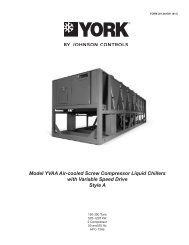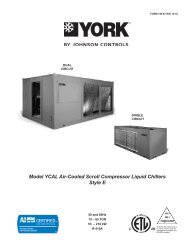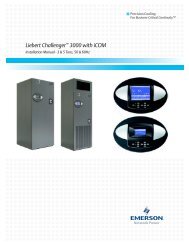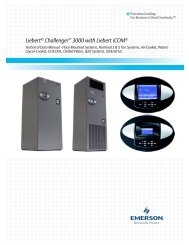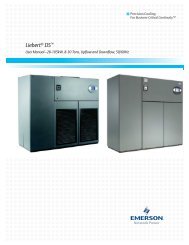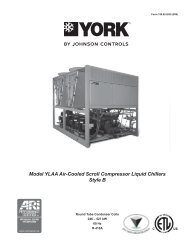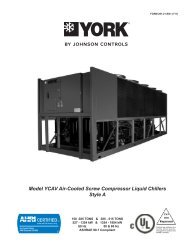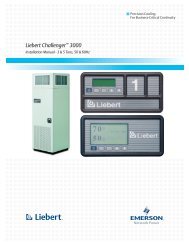Liebert Challenger 3000
Liebert Challenger™ 3000 Operation & Maintenance Manual - DCES
Liebert Challenger™ 3000 Operation & Maintenance Manual - DCES
Create successful ePaper yourself
Turn your PDF publications into a flip-book with our unique Google optimized e-Paper software.
2.2 Status DisplayOperation with Advanced Microprocessor ControlsThe display normally shown includes the present room temperature, humidity, active status functions(cooling, heating, dehumidifying, humidifying), and active alarms. If no keys are pressed within5 minutes, the system automatically returns to the Status Display. The Status Display may also beselected from the Main Menu.2.3 Main Menu Press the MENU/ESC key to display the Main Menu. The Menu selections include:• Status/alarm data•Setpoints/setup• Date and time• Status display2.4 Status/Alarm DataSelecting STATUS/ALARM DATA from the Main Menu will display the following selections:• Active alarms• Operating status• Alarm history log• Run hours log• Analog sensors2.4.1 Active AlarmsThis screen displays any active alarm. The alarms are numbered, #1 being the most recent. If thereare no active alarms, then “NO ALARMS PRESENT” will be displayed.2.4.2 Operating StatusThe Operating Status is intended to provide the user with displayed information concerning what thecontrol is calling for the system to do.For example: The display indicates the chilled water valve is 68% open. On a new call for cooling, ittakes several seconds for the valve to travel from fully closed to 68% open. So, when the display reads68%, it may take a few seconds for the valve to actually open 68%. Also, if the display indicates a compressoris operating but the compressor has not yet turned on, it may be off because of the short cyclecontrol (see 4.4.1 - Short Cycle Control).2.4.3 Alarm History LogNOTEThere may be some time lapse before a specific component matches the displayed number.A history of the 10 most recent alarms is kept in nonvolatile memory complete with the date and timethat the alarms occurred. The first alarm in the history is the most recent and the 10th is the oldest.If the alarm history is full (10 alarms) and a new alarm occurs, the oldest is lost and the newest issaved in alarm history location 1. The rest are moved down the list by 1. Alarm history on new unitsmay show the results of factory testing.5



